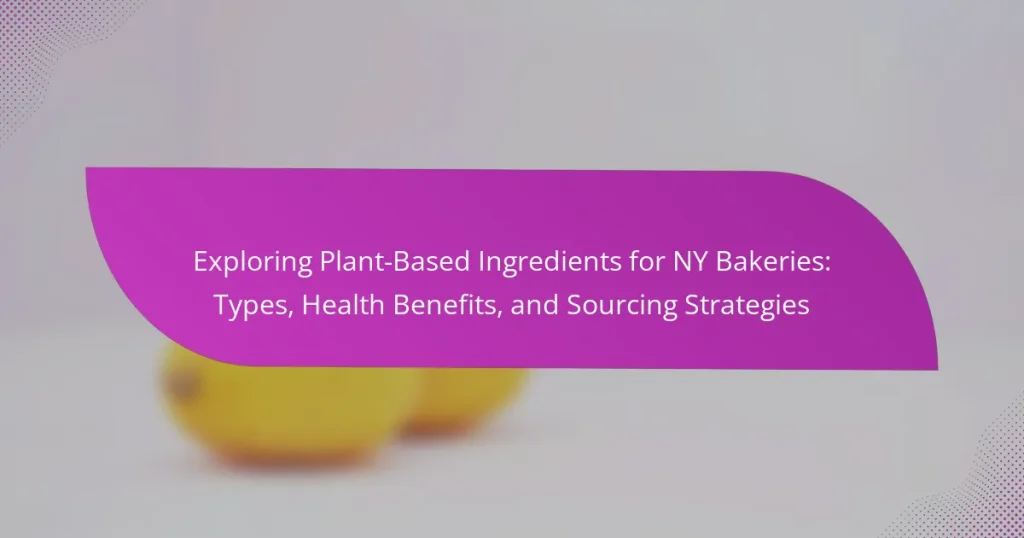Plant-based ingredients are essential components in New York bakeries, featuring alternatives such as almond flour, coconut oil, and aquafaba. These ingredients not only cater to vegan diets but also appeal to health-conscious consumers due to their associated health benefits, including lower cholesterol and improved heart health. The article explores various plant-based options, including fruits, vegetables, grains, legumes, nuts, and seeds, highlighting their nutritional contributions and roles in baking. Additionally, it provides sourcing strategies for bakeries, emphasizing the importance of reliable suppliers and market trends in obtaining high-quality plant-based products.

What are Plant-Based Ingredients for NY Bakeries?
Plant-based ingredients for NY bakeries include items like almond flour, coconut oil, and aquafaba. Almond flour serves as a gluten-free alternative to traditional flour. Coconut oil acts as a dairy-free fat source in recipes. Aquafaba, the liquid from canned chickpeas, can replace eggs in various baked goods. Other common plant-based ingredients are flaxseed meal and chia seeds, which also serve as egg substitutes. These ingredients cater to vegan diets and appeal to health-conscious consumers. The use of plant-based ingredients is rising due to increasing demand for vegan options. Studies show that plant-based diets can lead to health benefits, including lower cholesterol levels and improved heart health.
How do Plant-Based Ingredients differ from Traditional Ingredients?
Plant-based ingredients differ from traditional ingredients primarily in their source. Plant-based ingredients are derived from plants, while traditional ingredients often include animal products. For example, plant-based proteins come from legumes, nuts, and grains. Traditional proteins typically originate from meat, dairy, and eggs.
Nutritionally, plant-based ingredients can offer lower saturated fat and cholesterol levels. They are often rich in fiber, vitamins, and antioxidants. Traditional ingredients may provide higher protein density but can also contribute to higher fat and calorie intake.
Environmental impact is another distinguishing factor. Plant-based ingredients generally require fewer resources and produce lower greenhouse gas emissions compared to traditional animal-based ingredients. This aligns with sustainability initiatives in the food industry.
Consumer preferences are shifting towards plant-based options due to health and ethical considerations. A 2021 survey indicated that 60% of consumers are reducing meat consumption for health reasons. This trend highlights the growing demand for plant-based alternatives in various culinary applications.
What types of plant-based ingredients are commonly used in baking?
Common plant-based ingredients used in baking include flour, sugar, and plant-based fats. Flour, such as all-purpose or whole wheat, serves as the primary structure. Sugar, like cane or coconut sugar, adds sweetness. Plant-based fats include oils, margarine, or nut butters, providing moisture and richness. Additionally, ingredients like plant-based milk, applesauce, and flaxseed meal are used for binding and moisture. These ingredients cater to vegan and health-conscious bakers. The demand for plant-based baking options has increased significantly in recent years, reflecting a broader trend towards healthier eating.
What are the key characteristics of these ingredients?
The key characteristics of plant-based ingredients include their nutritional profile, sourcing sustainability, and versatility in baking. Nutritional profiles often feature high fiber, vitamins, and minerals. For example, ingredients like almond flour provide protein and healthy fats. Sourcing sustainability is crucial; many plant-based ingredients are sourced from organic farms. This reduces environmental impact and supports local economies. Versatility allows these ingredients to be used in various recipes, from breads to pastries. They can also cater to dietary restrictions, such as gluten-free or vegan diets. Overall, these ingredients enhance both health and culinary creativity in baking.
Why are Plant-Based Ingredients gaining popularity in NY Bakeries?
Plant-based ingredients are gaining popularity in NY bakeries due to increasing consumer demand for healthier options. Many customers are seeking alternatives to traditional animal-based products for health and ethical reasons. The rise of veganism and vegetarianism contributes to this trend. Additionally, plant-based ingredients often align with sustainability goals, appealing to environmentally conscious consumers. Research shows that sales of plant-based foods increased by 27% in 2020 alone. This shift is driving bakeries to innovate with ingredients like almond flour, coconut milk, and aquafaba. As a result, NY bakeries are expanding their menus to include more plant-based offerings.
What health benefits do Plant-Based Ingredients provide?
Plant-based ingredients provide numerous health benefits, including improved heart health, better digestion, and enhanced nutrient intake. They are often rich in fiber, which aids in digestion and helps maintain a healthy weight. Studies show that diets high in plant-based foods can lower cholesterol levels and reduce the risk of heart disease. For example, a study published in the Journal of the American Heart Association found that plant-based diets are associated with a 25% lower risk of heart disease. Additionally, plant-based ingredients are packed with vitamins, minerals, and antioxidants, which support overall health. These nutrients can help boost the immune system and reduce inflammation. Consuming more plant-based foods is also linked to lower rates of chronic diseases, such as diabetes and certain cancers.
How do these ingredients align with current dietary trends?
Plant-based ingredients align with current dietary trends by promoting health and sustainability. Many consumers are shifting towards plant-based diets for health benefits, including lower cholesterol and reduced risk of chronic diseases. The demand for vegan and vegetarian options is rising, with a 600% increase in plant-based food sales from 2014 to 2019, according to a report by the Plant Based Foods Association. Additionally, these ingredients cater to ethical considerations, as consumers increasingly prioritize animal welfare and environmental impact. The trend towards clean eating also supports the use of whole, minimally processed plant-based ingredients. Overall, plant-based ingredients resonate with health-conscious and environmentally aware consumers.
What are the challenges of using Plant-Based Ingredients?
The challenges of using plant-based ingredients include limited availability, variability in quality, and potential nutrient deficiencies. Sourcing plant-based ingredients can be difficult in certain regions. Seasonal fluctuations may affect ingredient consistency. Additionally, some plant-based alternatives may not replicate the texture or flavor of traditional ingredients. This can impact product acceptance among consumers. Nutritional profiles may vary widely among plant-based options. For instance, protein content in plant-based ingredients can be lower than that in animal products. These factors can complicate formulation and consumer satisfaction in bakery products.
How do taste and texture compare to traditional baking ingredients?
Plant-based ingredients often provide different taste and texture profiles compared to traditional baking ingredients. For instance, almond flour has a nuttier flavor and a coarser texture than wheat flour. Coconut oil adds a subtle sweetness and moisture, while butter offers richness and a creamy texture.
Additionally, plant-based milk alternatives, like almond or oat milk, can impart unique flavors and may alter the texture of baked goods. These alternatives can result in a denser product compared to traditional dairy milk.
The use of flaxseed or chia seeds as egg substitutes can create a slightly gelatinous texture, differing from the lightness that eggs typically provide.
Overall, while plant-based ingredients can enhance flavors and introduce new textures, they may require adjustments in recipes to achieve desired results.
What are the potential allergens associated with Plant-Based Ingredients?
Potential allergens associated with plant-based ingredients include soy, nuts, gluten, and sesame. Soy is commonly used in products like tofu and soy milk. Nuts, such as almonds and cashews, are often included in snacks and desserts. Gluten is present in wheat-based products, which can affect those with celiac disease. Sesame seeds are increasingly used in various baked goods and sauces. According to the Food Allergy Research and Education (FARE), these allergens can provoke severe reactions in sensitive individuals. Awareness of these allergens is crucial for safe food preparation in bakeries.

What Types of Plant-Based Ingredients are Available?
Plant-based ingredients include a variety of options such as fruits, vegetables, grains, legumes, nuts, and seeds. Fruits can be used for natural sweetness and flavor. Vegetables provide essential nutrients and textures. Grains like wheat, oats, and quinoa serve as foundational components. Legumes, including beans and lentils, are excellent protein sources. Nuts and seeds add healthy fats and crunch. Additionally, plant-based alternatives like almond milk and coconut oil are popular in baking. These ingredients cater to diverse dietary preferences and promote health benefits.
What are the main categories of Plant-Based Ingredients?
The main categories of plant-based ingredients include fruits, vegetables, grains, legumes, nuts, seeds, and herbs. Fruits provide natural sweetness and flavor. Vegetables add essential nutrients and color. Grains serve as a primary energy source and include options like wheat and rice. Legumes, such as beans and lentils, are rich in protein and fiber. Nuts and seeds offer healthy fats and texture. Herbs enhance flavor and aroma in dishes. Each category contributes unique attributes to plant-based recipes.
How do fruits and vegetables serve as ingredients in baking?
Fruits and vegetables enhance baking by providing moisture, flavor, and nutritional value. They can replace fats in recipes, making baked goods healthier. For example, applesauce can substitute for butter, reducing calories and fat content. Bananas add natural sweetness and moisture to breads and muffins. Carrots and zucchini contribute to texture and nutrients in cakes and breads. Additionally, fruits like berries can be used as toppings or fillings, adding vibrant color and flavor. The incorporation of these ingredients also increases the fiber content of baked goods, promoting better digestion.
What role do nuts and seeds play in plant-based baking?
Nuts and seeds serve multiple roles in plant-based baking. They provide essential nutrients, including healthy fats, protein, and fiber. Nuts like almonds and walnuts enhance texture and flavor in baked goods. Seeds such as flaxseeds and chia seeds act as binding agents when mixed with water. They can also replace eggs in recipes, offering a vegan alternative. The use of nuts and seeds contributes to the overall nutritional profile of baked items. For instance, almonds contain vitamin E, which is beneficial for skin health. Additionally, seeds add crunch and visual appeal to products like breads and muffins. Their versatility makes them key ingredients in creating satisfying plant-based treats.
Which alternative flours can be used in Plant-Based Baking?
Alternative flours used in plant-based baking include almond flour, coconut flour, oat flour, and chickpea flour. Almond flour is made from ground almonds and is high in protein and healthy fats. Coconut flour is derived from dried coconut meat and is rich in fiber. Oat flour is made from ground oats and provides a mild flavor and good texture. Chickpea flour, made from ground chickpeas, is high in protein and works well in savory baked goods. These flours offer diverse flavors and nutritional profiles, making them suitable for various plant-based recipes.
What are the benefits of using gluten-free flours?
Gluten-free flours offer several benefits for those with gluten sensitivities or celiac disease. They provide an alternative for individuals who cannot consume gluten, allowing for a wider variety of baked goods. Gluten-free flours, such as almond, coconut, and rice flour, often contain higher protein and fiber content compared to traditional wheat flour. This can contribute to better digestion and sustained energy levels. Additionally, gluten-free baking can cater to diverse dietary needs, including vegan and paleo diets. Studies show that gluten-free diets can reduce inflammation and improve gut health for those with gluten intolerance. Overall, using gluten-free flours enhances inclusivity in baking while promoting health for specific dietary requirements.
How do whole grain flours contribute to nutrition?
Whole grain flours contribute to nutrition by providing essential nutrients and dietary fiber. They retain the bran, germ, and endosperm of the grain, which are rich in vitamins, minerals, and antioxidants. Whole grain flours are a significant source of B vitamins, including thiamine, riboflavin, and niacin. These nutrients support energy metabolism and overall health. They also contain dietary fiber, which aids in digestion and helps maintain healthy cholesterol levels. Research shows that diets high in whole grains can reduce the risk of heart disease and type 2 diabetes. Additionally, whole grain flours have a lower glycemic index compared to refined flours, promoting better blood sugar control.
What are common plant-based sweeteners used in baking?
Common plant-based sweeteners used in baking include maple syrup, agave nectar, and coconut sugar. Maple syrup is derived from the sap of sugar maple trees. It has a distinct flavor and a lower glycemic index compared to refined sugars. Agave nectar is extracted from the agave plant. It is sweeter than honey and has a mild taste. Coconut sugar is made from the sap of coconut palm flowers. It retains some nutrients and has a caramel-like flavor. Other options include date sugar and brown rice syrup. Date sugar is made from ground dried dates and provides fiber. Brown rice syrup is produced from brown rice and has a mild sweetness. These sweeteners are popular for their natural origins and unique flavors.
How do natural sweeteners compare to refined sugars?
Natural sweeteners are generally considered healthier alternatives to refined sugars. They often contain beneficial nutrients and have a lower glycemic index. For example, honey and maple syrup provide vitamins and minerals. In contrast, refined sugars lack nutritional value and can lead to spikes in blood sugar levels. Studies show that excessive refined sugar consumption is linked to obesity and diabetes. Natural sweeteners, when used in moderation, may help reduce these health risks. Therefore, choosing natural sweeteners can support better overall health compared to refined sugars.
What are the advantages of using sugar alternatives?
Sugar alternatives offer several advantages over traditional sugar. They can help reduce calorie intake. Many sugar substitutes are lower in calories than sugar. This can assist in weight management. Sugar alternatives also have a lower glycemic index. This means they cause less impact on blood sugar levels. Some alternatives contain beneficial nutrients, such as fiber. For example, stevia is derived from a plant and contains no calories. Research indicates that using sugar alternatives may improve dental health. Unlike sugar, many substitutes do not contribute to tooth decay.

How to Source Plant-Based Ingredients for NY Bakeries?
To source plant-based ingredients for NY bakeries, identify reliable suppliers that specialize in plant-based products. Research local farms and distributors that offer organic and sustainable options. Establish relationships with wholesalers who provide a variety of plant-based ingredients. Attend trade shows and food expos to connect with vendors. Utilize online platforms that cater to plant-based baking ingredients. Join local culinary groups or networks for recommendations on sourcing. Verify the quality and sourcing practices of suppliers to ensure they meet bakery standards. Regularly review market trends to adapt to new ingredient offerings.
What are effective strategies for sourcing quality ingredients?
Effective strategies for sourcing quality ingredients include establishing relationships with local farmers and suppliers. Building direct connections ensures access to fresh, seasonal produce. Visiting farmers’ markets can provide insights into ingredient quality and sourcing practices. Conducting thorough research on suppliers helps identify those who prioritize sustainable and ethical practices. Utilizing online platforms that specialize in organic and local ingredients can streamline the sourcing process. Regularly attending industry trade shows can expose bakers to new suppliers and innovative products. Implementing a quality control process ensures that all ingredients meet the desired standards. Collaborating with other bakers can lead to shared resources and bulk purchasing opportunities.
How can bakeries establish relationships with local suppliers?
Bakeries can establish relationships with local suppliers by engaging in direct communication and fostering trust. They should initiate conversations with local farmers and producers to understand their offerings. Attending local farmers’ markets can facilitate these connections. Building rapport through regular visits and inquiries about their products is essential. Offering to collaborate on special products can strengthen the partnership. Additionally, consistent ordering and timely payments demonstrate reliability. Transparency about needs and expectations can enhance the relationship. According to a study by the American Farm Bureau Federation, local sourcing boosts community ties and supports local economies.
What certifications should bakeries look for when sourcing ingredients?
Bakeries should look for certifications such as USDA Organic, Non-GMO Project Verified, and Fair Trade. USDA Organic certification ensures that ingredients are grown without synthetic pesticides or fertilizers. Non-GMO Project Verified indicates that ingredients are free from genetically modified organisms. Fair Trade certification ensures ethical sourcing practices and fair compensation for farmers. These certifications support quality and sustainability in ingredient sourcing. They also align with consumer demand for transparency and ethical practices.
How can bakeries ensure sustainability in their sourcing practices?
Bakeries can ensure sustainability in their sourcing practices by selecting local and organic ingredients. This reduces transportation emissions and supports local economies. They should prioritize suppliers who implement sustainable farming practices. Using seasonal ingredients also minimizes environmental impact. Bakeries can adopt certifications like Fair Trade and Rainforest Alliance. These certifications ensure ethical sourcing and environmental responsibility. Additionally, bakeries can establish direct relationships with farmers. This fosters transparency and accountability in sourcing. By integrating these strategies, bakeries contribute to a more sustainable food system.
What are the benefits of sourcing organic ingredients?
Sourcing organic ingredients provides numerous benefits. Organic ingredients are grown without synthetic pesticides or fertilizers. This promotes environmental sustainability and biodiversity. Health-wise, organic foods are often richer in nutrients. Studies indicate they may contain higher levels of antioxidants. Sourcing organic supports local farmers and economies. It can enhance a bakery’s reputation for quality. Additionally, organic ingredients often have superior flavor profiles. This can improve the overall taste of baked goods.
How can bakeries reduce their carbon footprint through sourcing?
Bakeries can reduce their carbon footprint through sourcing by choosing local and sustainable ingredients. Local sourcing minimizes transportation emissions associated with ingredient delivery. Sustainable ingredients, such as organic grains, often require fewer chemical inputs, reducing environmental impact.
By prioritizing plant-based ingredients, bakeries can also lower greenhouse gas emissions compared to animal-based products. Research indicates that plant-based diets can reduce carbon footprints by up to 50%. Furthermore, bakeries can engage with suppliers who practice regenerative agriculture, which enhances soil health and carbon sequestration.
Implementing these sourcing strategies not only supports environmental sustainability but also appeals to eco-conscious consumers.
What are best practices for incorporating Plant-Based Ingredients in recipes?
Use fresh, seasonal plant-based ingredients for optimal flavor and nutrition. Incorporate a variety of colors and textures to enhance visual appeal. Experiment with different cooking methods, such as roasting or steaming, to bring out unique flavors. Balance flavors by combining sweet, salty, sour, and umami elements. Utilize plant-based fats like olive oil or avocado for richness. Substitute traditional dairy with alternatives like almond milk or coconut yogurt. Ensure proper seasoning to elevate the taste of plant-based dishes. Research indicates that diverse plant-based diets can improve overall health and well-being.
How can bakeries experiment with ratios and combinations of ingredients?
Bakeries can experiment with ratios and combinations of ingredients by adjusting the proportions of flour, sugar, fats, and liquids. This experimentation allows for variations in texture, flavor, and nutritional content. For example, increasing the fat ratio can create a richer product. Conversely, reducing sugar can yield a less sweet outcome.
Bakeries can also incorporate different types of flours, such as almond or oat, to explore gluten-free options. By blending various plant-based ingredients, they can enhance flavor profiles and health benefits. Testing these combinations in small batches allows for controlled results and adjustments.
Research indicates that ingredient ratios significantly impact the final product’s quality. A study by the American Institute of Baking highlights how subtle changes in ingredient ratios can affect dough behavior and baking performance. This evidence supports the practice of experimentation in baking.
What tips can enhance the flavor and texture of plant-based baked goods?
To enhance the flavor and texture of plant-based baked goods, use a variety of plant-based ingredients. Incorporating ingredients like nut butters can add creaminess and richness. Utilizing aquafaba as an egg substitute can improve texture and moisture. Adding spices such as cinnamon or vanilla can elevate flavor profiles significantly. Using ripe fruits like bananas or applesauce can provide natural sweetness and moisture. Incorporating whole grains instead of refined flours can enhance texture and nutritional value. Experimenting with different types of plant milks can also affect flavor and moisture. Lastly, allowing batters to rest can improve texture by hydrating the flour. These methods are supported by various baking practices that show significant improvements in plant-based recipes.
The main entity of this article is plant-based ingredients used in NY bakeries. It provides a comprehensive overview of various types of plant-based ingredients, including almond flour, coconut oil, and aquafaba, highlighting their health benefits and nutritional profiles. The article discusses the differences between plant-based and traditional ingredients, the rising popularity of plant-based options in baking, and effective sourcing strategies for these ingredients. Additionally, it addresses the challenges associated with using plant-based ingredients and offers insights into best practices for incorporating them into recipes, emphasizing their role in promoting health and sustainability.




